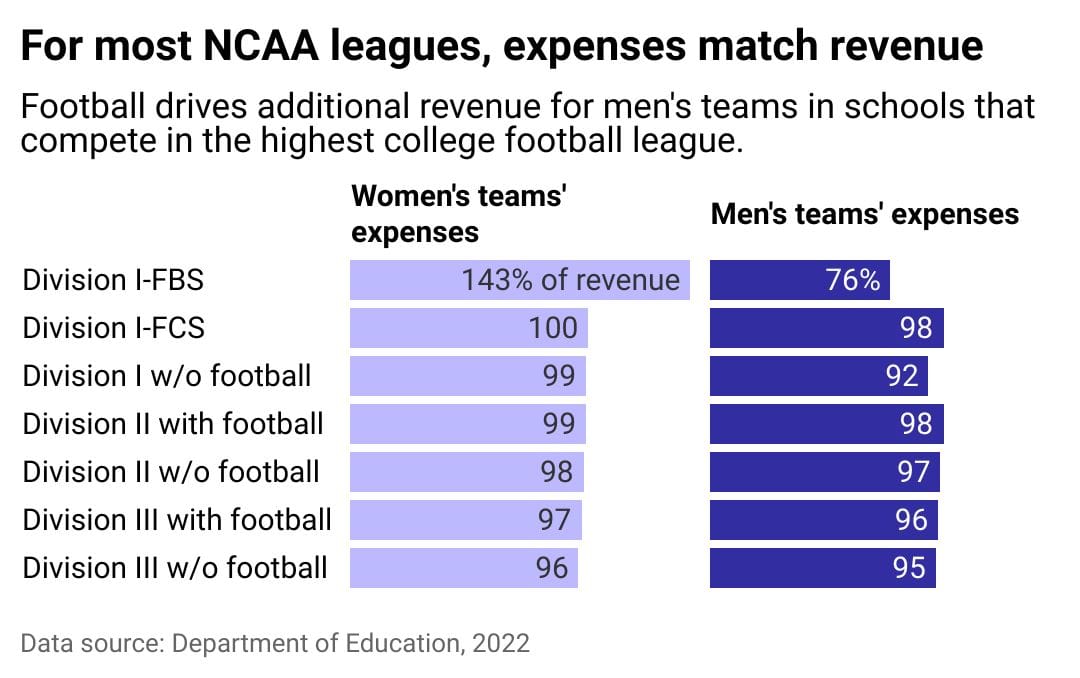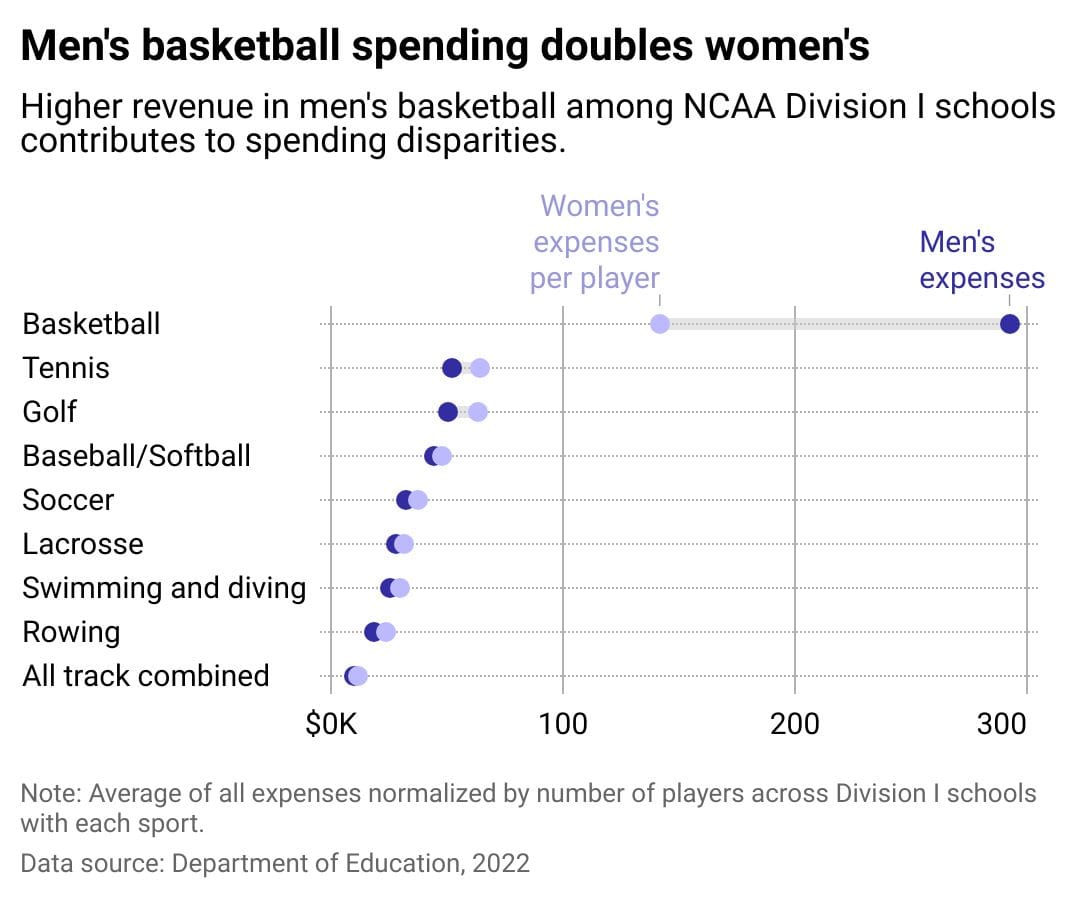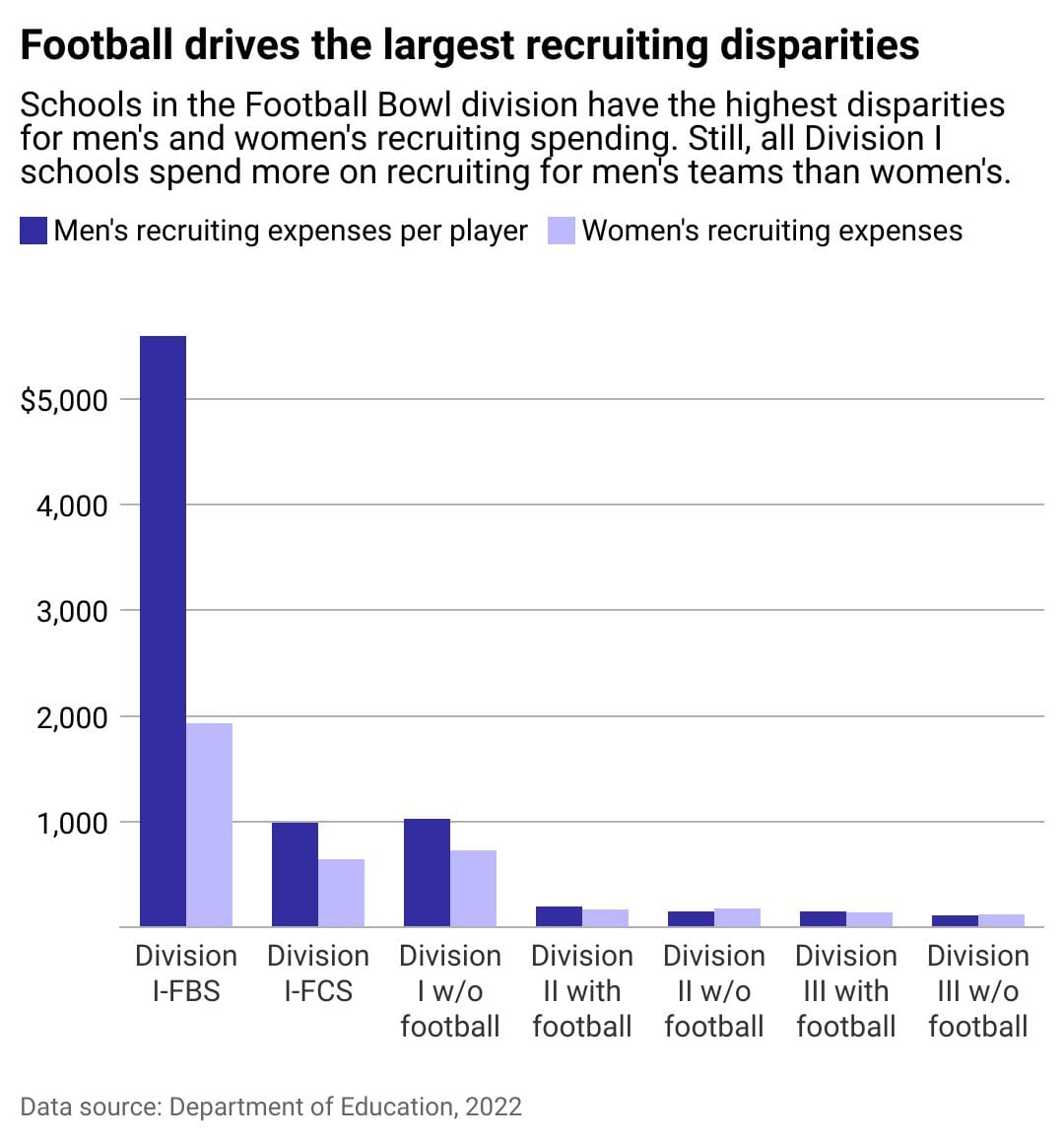In the Interest of Profits, Female Student-Athletes Get Left Behind
Despite female sports viewership reaching record-breaking highs, and more than 50 years after the passage of Title IX, collegiate female sports programs are still grossly underfunded compared to male athletics.
To better understand the landscape of unequal treatment across gender in collegiate sports, Bold.org used data from the Department of Education to examine disparities in funding and treatment for collegiate female sports programs in the U.S.
A comparison of university expenses for men's athletic teams versus women's teams yields a widely disparate funding picture: Across NCAA schools, men's teams are routinely funded at higher rates than women's teams, sometimes at triple the rate.
These funding discrepancies don't reflect the revenue or viewership these women's teams garner. Take the University of Iowa, for example. Despite a highly watched women's basketball season in 2022, the women's team received only 79% of the funding than the men's team.
Even at the championship level, women's teams are enormously undervalued.
The final NCAA tournament game in women's basketball this year was the most watched basketball game of among men's or women's and college or professional teams since 2019. But the final four teams in the 2024 NCAA men's basketball tournament earned $10 million each for their conferences, while the women's teams received nothing for the same championship performance.
Title IX, passed in 1972, is a federal civil rights law implemented to correct gender discrimination in educational programs, specifically unequal opportunities in collegiate sports. Universities that receive federal student aid funding are covered by Title IX, ensuring all students are provided an equal opportunity to participate in school athletic programs, at the club, intramural, and intercollegiate levels. Many have challenged Title IX since its passage.
Title IX also protects students, including student-athletes, against sexual harassment and sexual violence. In 2016, the DOE and DOJ issued guidance on protecting transgender students, clarifying that schools are permitted to operate sex-segregated athletic teams but cannot adopt requirements based on stereotypical assumptions.
Yet, the Women's Sports Foundation estimates that 80-90% of all educational institutions do not comply with Title IX. A 2021 report by New York law firm Kaplan Hecker & Fink found that the NCAA has underfunded and undervalued women's programs, noting various instances of systemic gender inequity in the NCAA's treatment of women's teams.

SCHOLARSHIPS - FIGHTING STUDENT DEBT
Find exclusive scholarships for college at Bold.org.
Differences in Expenses Often Tied to Differences in Revenue
Critics often note that women's teams earn less than men's to justify funding discrepancies. Yet, the Department of Education data shows that revenue matches expenses for both men's and women's teams.
In other words, women's teams yield the same revenue as men's teams do relative to their funding. Even when women's teams yield the same financial turnout relative to their expenses, they are still allocated less funding, most notably among basketball teams.
Across Division I basketball teams, schools spent a whopping $93 million more on men than women, for equipment, recruiting, and travel expenses—a 60% funding disparity, according to a USA Today analysis published in 2022. Funding disparities are glaring among NCAA single-gender sports, like beach volleyball and wrestling, where the NCAA spends over $2,000 more per student-athlete for men's championships than women's, according to Kaplan Hecker & Fink's report.

BEST SCHOLARSHIPS FOR HIGH SCHOOL SENIORS
Search here for the best scholarships for high school seniors on Bold.org!
The Problem with Revenue Determining Budgets in College Athletics
Expenses for recruiting, game day needs, and travel, which differ immensely across sports, also reflect unequal allocation across gender differences, even when comparing the same sports. USA Today's analysis found universities spend 62 cents on travel-associated costs for women's basketball games for every dollar they spend on men's games.
The University of Louisville spent $754,265 on its men's basketball team and $24,157 on its women's team—a funding ratio of 31 to 22. The inequality is even more apparent when you consider that Louisville's women's basketball team has qualified for the NCAA tournament for the past 13 years, while the men's team only qualified seven times in the same time frame, most recently in 2019.

GRADUATE STUDENT SCHOLARSHIPS
Access thousands of exclusive, fully-funded scholarships for graduate students with upcoming deadlines.
Recruitment Budgets Also Diverge by Gender for Division I Schools
Schools in the football division have the highest disparities in funding between their male and female athletic recruiting spending.
Recruiting disparities remain even when accounting for football. USA Today points out that female athletic programs in basketball, softball, soccer, tennis, and golf are all experiencing recruitment underfunding compared to male teams. The amount universities across the NCAA spend on recruiting male athletes is up to quadruple the amount that they spend on women athletes. However, it's not due to lack of interest. A 2022 report from the NCAA found participation in girls' high school sports is more than 10 times greater than it was when Title IX passed, reaching 3.4 million student-athletes in 2019.
Story editing by Elena Cox. Copy editing by Kristen Wegrzyn.

About Halle
Halle Young is a Bay Area-based writer and Medical Anthropology Ph.D. student at UCSF-UC Berkeley. She studies stigmatized chronic pain, therapeutics, and pleasure.